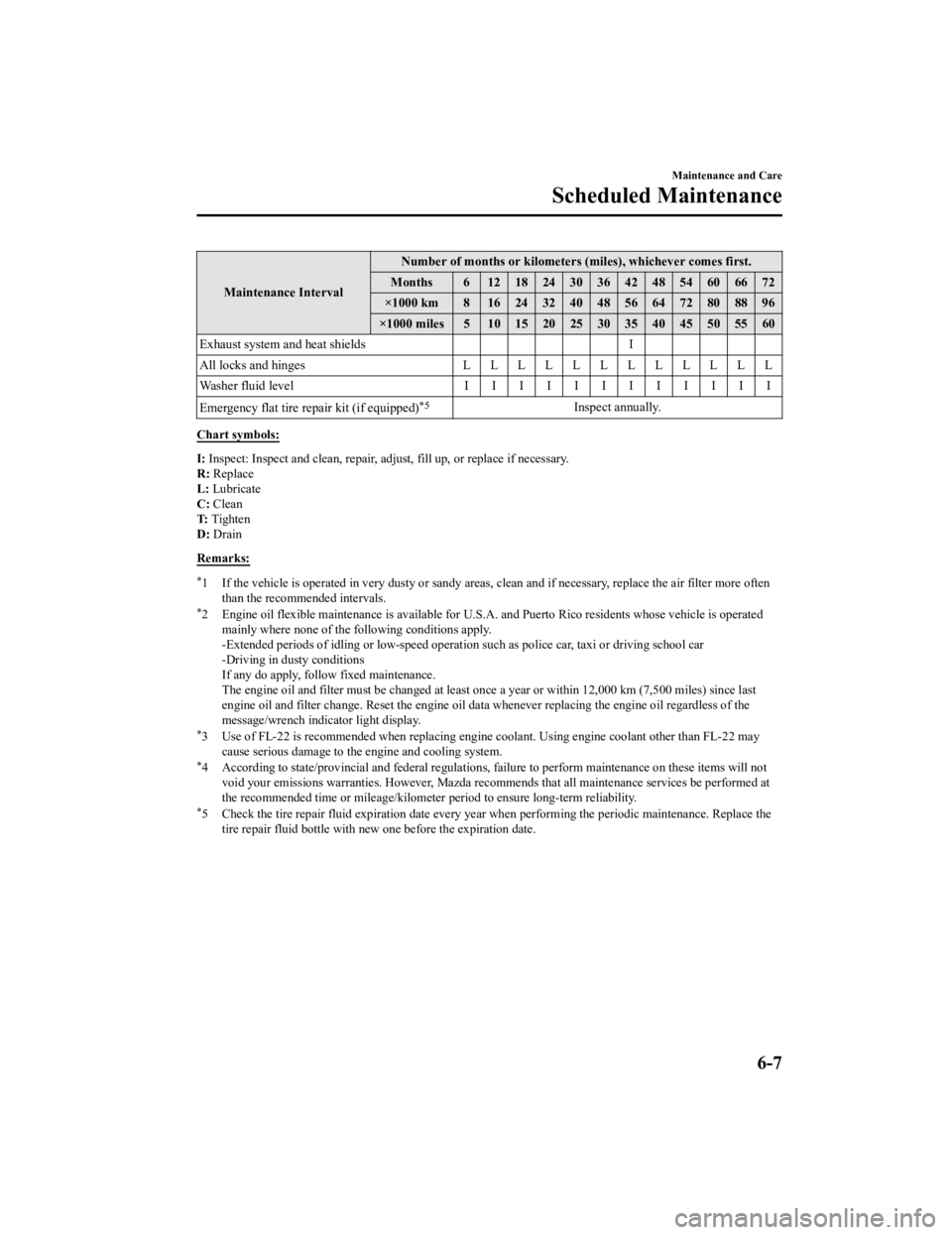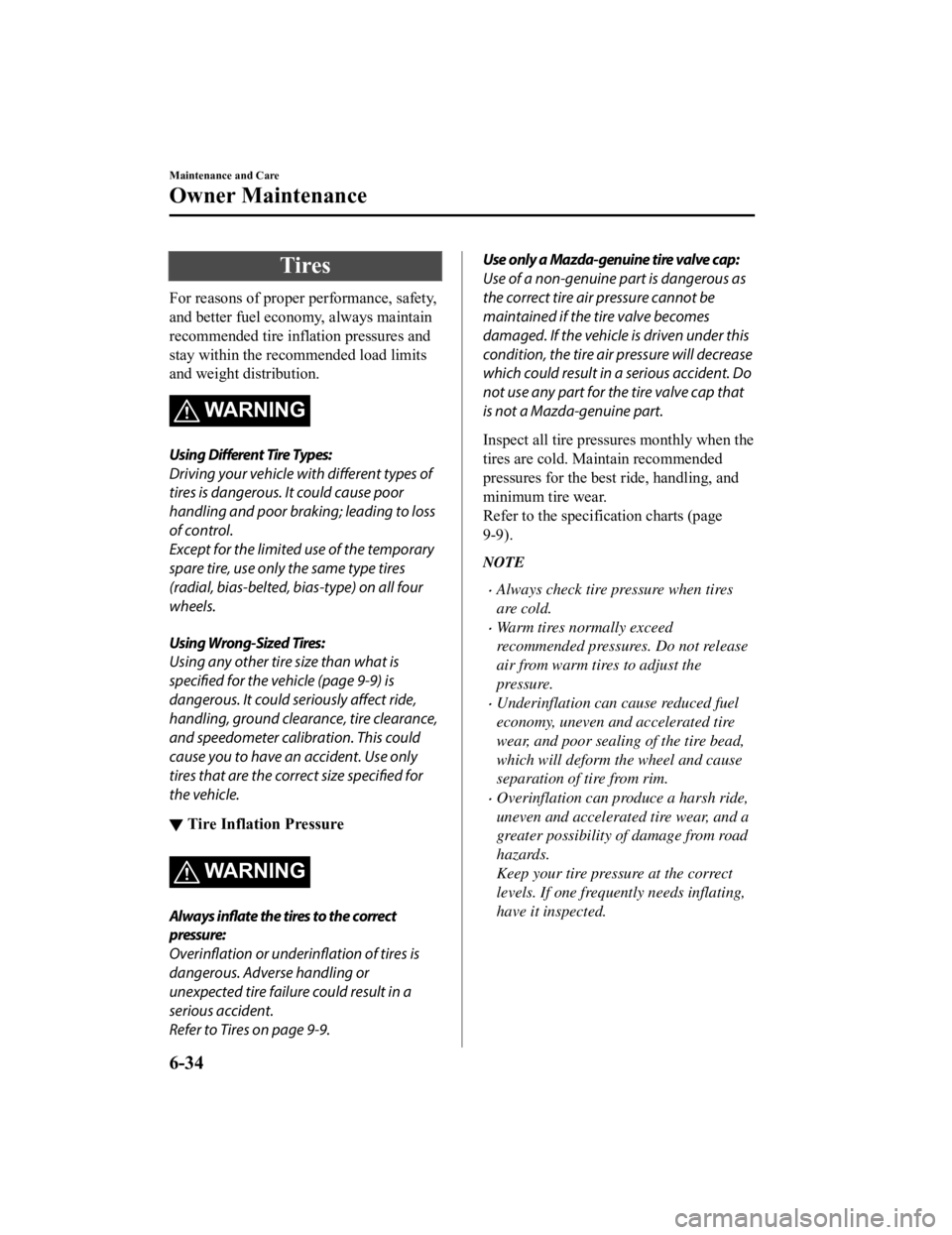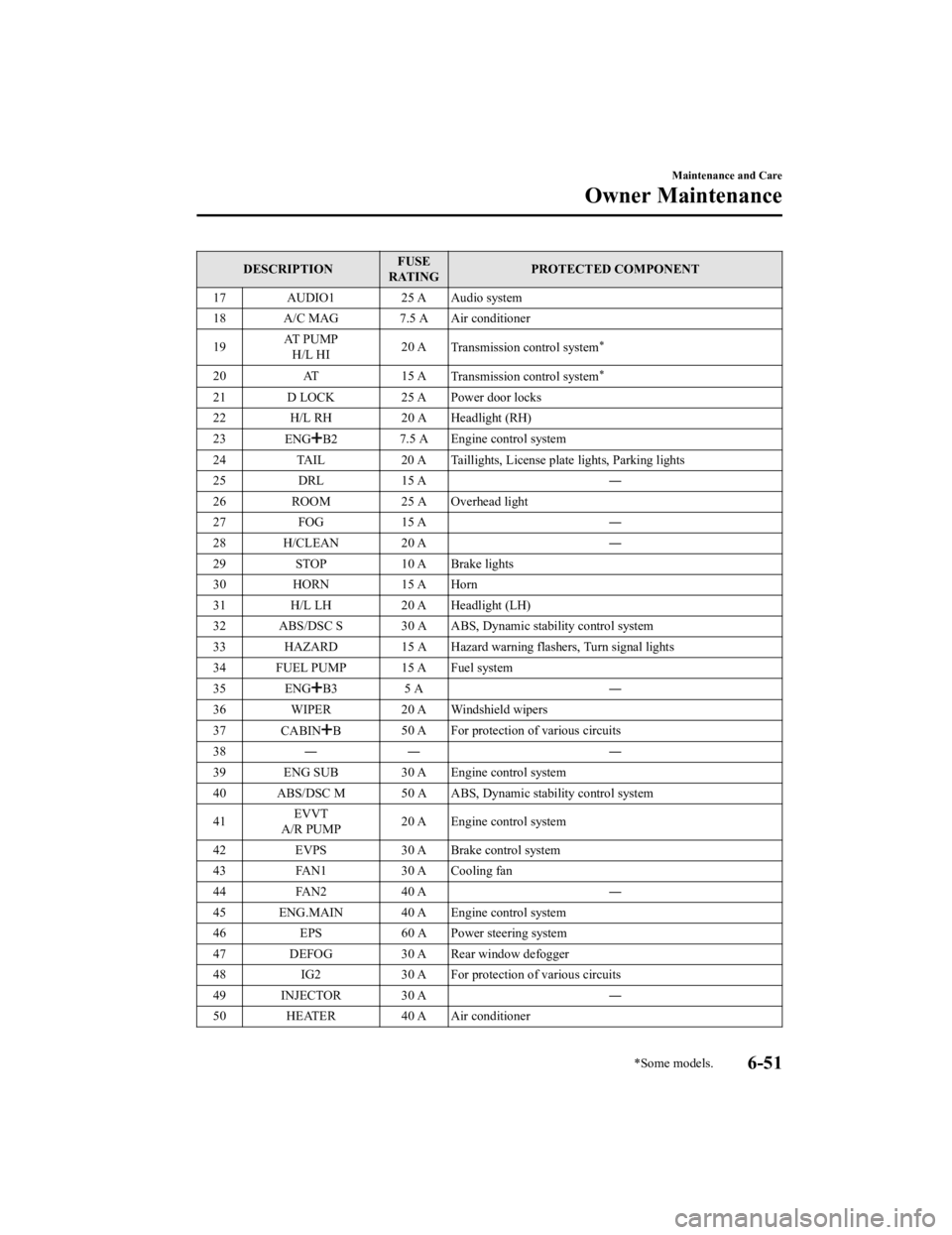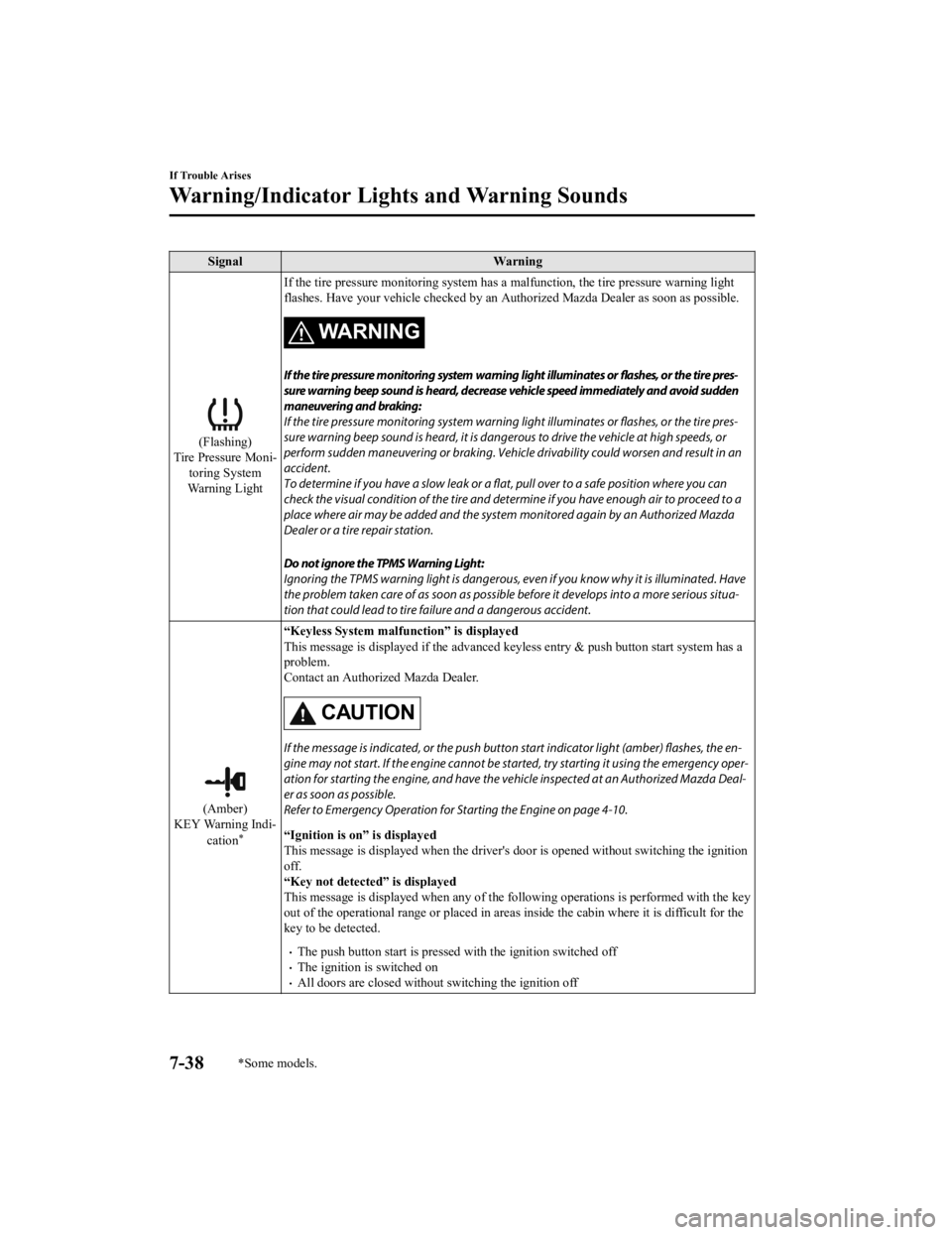air condition MAZDA MODEL MX-5 MIATA RF 2021 Owner's Guide
[x] Cancel search | Manufacturer: MAZDA, Model Year: 2021, Model line: MODEL MX-5 MIATA RF, Model: MAZDA MODEL MX-5 MIATA RF 2021Pages: 499, PDF Size: 6.83 MB
Page 304 of 499

Maintenance IntervalNumber of months or kilometers (miles), whichever comes first.
Months 6 1218243036424854606672
×1000 km 8 1624324048566472808896
×1000 miles 5 10 15 20 25 30 35 40 45 50 55 60
Exhaust system and heat shields I
All locks and hinges LLLLLLLLLLLL
Washer fluid level IIIIIIIIIIII
Emergency flat tire repair kit (if equipped)
*5Inspect annually.
Chart symbols:
I: Inspect: Inspect and clean, re pair, adjust, fill up, or replac e if necessary.
R: Replace
L: Lubricate
C: Clean
T: Tighten
D: Drain
Remarks:
*1 If the vehicle is operated in v ery dusty or sandy areas, clean and if necessary, replace the air filter more often
than the recommended intervals.
*2 Engine oil flexible maintenance i s available for U.S.A. and Puerto Rico residents whose vehicle is operated
mainly where none of the following conditions apply.
-Extended periods of idling or l ow-speed operation such as poli ce car, taxi or driving school car
-Driving in dusty conditions
If any do apply, follo w fixed maintenance.
The engine oil and filter must be changed at least once a year or within 12,000 km (7,500 miles) since last
engine oil and filter change. Res et the engine oil data whenever replacing the engine oil regardless of the
message/wrench indicator light display.
*3 Use of FL-22 is recommended wh en replacing engine coolant. Using engine coolant other than FL-22 may
cause serious damage to the engine and cooling system.
*4 According to state/provincial and federal regulations, failure to perform maintenance on these items will not
void your emissions warranties. However, Mazda recommends that all maintenance services be performed at
the recommended time or mileage/ kilometer period to ensure long-term reliability.
*5 Check the tire repair fluid exp iration date every year when performing the periodic maintenance. Replace the
tire repair fluid bottle with new one before the expiration date.
Maintenance and Care
Scheduled Maintenance
6-7
MX-5_8JS9-EA-20K_Edition1_old 2020-8-28 13:50:01
Page 307 of 499

Scheduled Maintenance (Mexico)
Follow Schedule 1 if the vehicle is operated mainly where none of the following conditions
(severe driving conditions) apply.
Repeated short-distance driving
Driving in dusty conditions
Driving with extended use of brakes
Driving in areas where salt or other corrosive materials are us ed
Driving on rough or muddy roads
Extended periods of idling or low-speed operation
Driving for long periods in cold temperatures or extremely humi d climates
Driving in extremely hot conditions
Driving in mountainous conditions continually
If any do apply, follow Schedule 2.
NOTE
For maintenance guidelines beyond the kilome ters/months listed, follow the maintenance
intervals provided in the Scheduled Maintenance Tables.
▼ Schedule 1
Maintenance Interval Number of months or kilometers, whichever comes first
Months 6 1218243036424854606672
×1000 km 102030405060708090100110120
Drive belts II I
Engine oil & filter RRRRRRRRRRRR
Cooling system II I
Engine coolant
*1Replace at first 200,000 km or 10 years; after that, every 100,000 km or 5 years
Air filter RRRRRR
Fuel lines and hoses I
*2I*2I
Hoses and tubes for emission I
*2I*2I
Fuel filter Replace every 60,000 km
Spark plugs IIIIIIIIIIII
Replace every 120,000 km
Brake lines, hoses and connections IIIIII
Brake and clutch fluid level I I I I I I I I I
Brake fluid RRR
Disc brakes IIIIIIIIIIII
Manual transmission oil R
Maintenance and Care
Scheduled Maintenance
6-10
MX-5_8JS9-EA-20K_Edition1_old 2020-8-28 13:50:01
Page 331 of 499

Tires
For reasons of proper performance, safety,
and better fuel economy, always maintain
recommended tire inflation pressures and
stay within the recommended load limits
and weight distribution.
WA R N I N G
Using Different Tire Types:
Driving your vehicle with different types of
tires is dangerous. It could cause poor
handling and poor braking; leading to loss
of control.
Except for the limited use of the temporary
spare tire, use only the same type tires
(radial, bias-belted, bias-type) on all four
wheels.
Using Wrong-Sized Tires:
Using any other tire size than what is
specified for the vehicle (page 9-9) is
dangerous. It could seriously affect ride,
handling, ground clearance, tire clearance,
and speedometer calibration. This could
cause you to have an accident. Use only
tires that are the correct size specified for
the vehicle.
▼ Tire Inflation Pressure
WA R N I N G
Always inflate the tires to the correct
pressure:
Overinflation or underinflation of tires is
dangerous. Adverse handling or
unexpected tire failure could result in a
serious accident.
Refer to Tires on page 9-9.
Use only a Mazda-genuine tire valve cap:
Use of a non-genuine part is dangerous as
the correct tire air pressure cannot be
maintained if the tire valve becomes
damaged. If the vehicle is driven under this
condition, the tire air pressure will decrease
which could result in a serious accident. Do
not use any part for the tire valve cap that
is not a Mazda-genuine part.
Inspect all tire pressures monthly when the
tires are cold. Maintain recommended
pressures for the best
ride, handling, and
minimum tire wear.
Refer to the specification charts (page
9-9).
NOTE
Always check tire pressure when tires
are cold.
Warm tires normally exceed
recommended pressures. Do not release
air from warm tires to adjust the
pressure.
Underinflation can cause reduced fuel
economy, uneven and accelerated tire
wear, and poor sealing of the tire bead,
which will deform the wheel and cause
separation of tire from rim.
Overinflation can produce a harsh ride,
uneven and accelerated tire wear, and a
greater possibility of damage from road
hazards.
Keep your tire pressure at the correct
levels. If one frequen tly needs inflating,
have it inspected.
Maintenance and Care
Owner Maintenance
6-34
MX-5_8JS9-EA-20K_Edition1_old 2020-8-28 13:50:01
Page 348 of 499

DESCRIPTIONFUSE
RATING PROTECTED COMPONENT
17 AUDIO1 25 A Audio system
18 A/C MAG 7.5 A Air conditioner
19 AT P U M P
H/L HI 20 A
Transmission control system
*
20 AT 15 A
Transmission control system*
21 D LOCK 25 A Power door locks
22 H/L RH 20 A Headlight (RH)
23 ENG
B2 7.5 A Engine control system
24 TAIL 20 A Taillights, License p late lights, Parking lights
25 DRL 15 A ―
26 ROOM 25 A Overhead light
27 FOG 15 A ―
28 H/CLEAN 20 A ―
29 STOP 10 A Brake lights
30 HORN 15 A Horn
31 H/L LH 20 A Headlight (LH)
32 ABS/DSC S 30 A ABS, Dynamic stability control system
33 HAZARD 15 A Hazard warning flashers, Turn signal lights
34 FUEL PUMP 15 A Fuel system
35 ENG
B3 5 A ―
36 WIPER 20 A Windshield wipers
37 CABIN
B 50 A For protection of various circuits
38 ― ― ―
39 ENG SUB 30 A Engine control system
40 ABS/DSC M 50 A ABS, Dynamic stability control system
41 EVVT
A/R PUMP 20 A Engine control system
42 EVPS 30 A Brake control system
43 FAN1 30 A Cooling fan
44 FAN2 40 A ―
45 ENG.MAIN 40 A Engine control system
46 EPS 60 A Power steering system
47 DEFOG 30 A Rear window defogger
48 IG2 30 A For protectio n of various circuits
49 INJECTOR 30 A ―
50 HEATER 40 A Air conditioner
Maintenance and Care
Owner Maintenance
*Some models.6-51
MX-5_8JS9-EA-20K_Edition1_old 2020-8-28 13:50:01
Page 370 of 499

6. Shake the sealant bottle to mix thecontents. Then extend the injection
hose.
Injection hose
CAUTION
Do not shake the bottle excessively.
Otherwise, the sealant could spray out
of the injection hose, and if the sealant
contacts clothing or other objects, you
may not be able to remove it.
NOTE
The sealant hardens easily and
injecting it will be difficult under cold
weather conditions (0 °C (32 °F) or
below). Warm the sealant inside the
vehicle to facilitate injection.
7. Pull out the air compressor hose and
the air compressor plug from the air
compressor.
Compressor hose
8. Install the air compressor hose whichwas pulled out of the air compressor to
the injection valve of the bottle.
Compressor hose Injection hose
Injection
valve
CAUTION
Make sure that the air compressor
switch is off before inserting the air
compressor hose to the injection valve
of the bottle. If the air compressor hose
is not installed to the injection valve of
the bottle securely, the sealant may
leak.
9. Remove the valve cap from the valve of the flat tire, install the injection hose
to the tire valve, turn the sleeve to the
right, and tighten it.
Valve cap
Valve Injection hose
If Trouble Arises
Flat Tire
7-7
MX-5_8JS9-EA-20K_Edition1_old
2020-8-28 13:50:01
Page 375 of 499

CAUTION
If the bottle is shaken after the injection
hose is screwed on, tire sealant could
spray out from the injection hose. Tire
sealant contacting clothing or other
objects may be impossible to remove.
Shake the bottle before screwing on the
injection hose.
NOTE
The sealant hardens easily and
injecting it will be difficult under cold
weather conditions (0 °C (32 °F) or
below). Warm the sealant inside the
vehicle to facilitate injection.
7. Remove the cap from the bottle. Screw on the injection hose with the bottle's
inner cap left on to break the inner cap.
Cap
Injection hose
Tire sealant
8. Remove the valve cap from the flat tire. Press the back of a valve core tool
to the core of the tire valve and bleed
all the remaining air.
Valve core tool
Valve
Valve cap
CAUTION
If there is air remaining in the tire when
the valve core is removed, the valve
core could fly out. Remove the valve
core carefully.
9. Turn the valve core counterclockwise with the valve core tool and remove
the valve core.
Valve Valve core
NOTE
Store the valve core in a place where it
will not get dirty.
If Trouble Arises
Flat Tire
7-12
MX-5_8JS9-EA-20K_Edition1_old 2020-8-28 13:50:01
Page 390 of 499

Overheating
If the temperature gauge indicates
overheating or the high engine coolant
temperature warning light turns on, the
vehicle loses power, or you hear a loud
knocking or pinging noise, the engine is
probably too hot.
WARNING
Pull over to a safe location, then switch
the ignition off and make sure the fan is
not running before attempting to work
near the cooling fan:
Working near the cooling fan when it is
running is dangerous. The fan could
continue running indefinitely even if the
engine has stopped and the engine
compartment temperature is high. You
could be hit by the fan and seriously
injured.
Do not remove either cooling
system cap when the engine and radiator
are hot:
When the engine and radiator are hot,
scalding coolant and steam may shoot out
under pressure and cause serious injury.
Open the hood ONLY after steam is no
longer escaping from the engine:
Steam from an overheated engine is
dangerous. The escaping steam could
seriously burn you.
If the temperature gauge indicates
overheating or the high engine coolant
temperature warning light turns on:
1. Drive safely to the side of the road and
park off the right-of-way.
2. Put a vehicle with an automatic transmission in park (P), a manual
transmission in neutral.
3. Apply the parking brake.
4. Turn off the air conditioner.
5. Check whether coolant or steam is escaping from the engine
compartment.
If steam is coming from the engine
compartment:
Do not go near the front of the vehicle.
Stop the engine.
Wait until the steam dissipates, then
open the hood and start the engine.
If neither coolant nor steam is
escaping:
Open the hood and idle the engine
until it cools.
CAUTION
If the cooling fan does not operate
while the engine is running, the engine
temperature will increase. Stop the
engine and call an Authorized Mazda
Dealer.
If Trouble Arises
Overheating
7-27
MX-5_8JS9-EA-20K_Edition1_old 2020-8-28 13:50:01
Page 400 of 499

SignalWarning
Check Engine LightIf this light illuminates while dr
iving, the vehicle may have a problem. It is important to
note the driving conditions when the light illuminated and cons ult an Authorized Mazda
Dealer.
The check engine light may illumi nate in the following cases:
The engine's electrical system has a problem.The emission control system has a problem.The fuel tank level being very low or approaching empty.The fuel-filler cap is missing or not tightened securely.
If the check engine light remains on, or it flashes continuously , do not drive at high
speeds and consult an Authorized Mazda Dealer as soon as possible.
Automatic Trans‐
mission Indication/
Warning Light
*
The indication/light illuminates when the transmission has a pr oblem.
CAUTION
If the automatic transmission warning indication/light illuminates, the transmission has an
electrical problem. Continuing to drive your Mazda in this condition could cause damage to
your transmission. Consult an Authorized Mazda Dealer as soon as possible.
(Turns on)
TCS/DSC Indicator Light If the light stays on, the TCS, DSC or the brake assist system
may have a malfunction and
they may not operate correctly. Take your vehicle to an Authori zed Mazda Dealer.
Air Bag/Seat Belt
Pretensioner System Warning Light A system malfunction is indicated
if the warning light constantly flashes, constantly illu‐
minates or does not illuminate a t all when the ignition is switched ON. If any of these oc‐
cur, consult an Authorized Mazda Dealer as soon as possible. The system may not operate
in an accident.WA R N I N G
Never tamper with the air bag/pretensioner systems and always have an Authorized Mazda
Dealer perform all servicing and repairs:
Self-servicing or tampering with the systems is dangerous. An air bag/pretensioner could
accidentally activate or become disabled causing serious injury or death.
If Trouble Arises
Warning/Indicator Lights and Warning Sounds
*Some models.7-37
MX-5_8JS9-EA-20K_Edition1_old 2020-8-28 13:50:01
Page 401 of 499

SignalWarning
(Flashing)
Tire Pressure Moni‐ toring System
Warning Light If the tire pressure monitoring s
ystem has a malfunction, the tire pressure warning light
flashes. Have your vehicle check ed by an Authorized Mazda Deale r as soon as possible.
WARNING
If the tire pressure monitoring system warning light illuminates or
flashes, or the tire pres‐
sure warning beep sound is heard, decrease vehicle speed immediately and avoid sudden
maneuvering and braking:
If the tire pressure monitoring system warning light illuminates or flashes, or the tire pres‐
sure warning beep sound is heard, it is dang erous to drive the vehicle at high speeds, or
perform sudden maneuver ing or braking. Vehicle drivabilit y could worsen and result in an
accident.
To determine if you have a slow leak or a flat, pull over to a safe position where you can
check the visual condition of the tire and determine if you have enough air to proceed to a
place where air may be added and the system monitored again by an Authorized Mazda
Dealer or a tire repair station.
Do not ignore the TPMS Warning Light:
Ignoring the TPMS warning light is dangerous, even if you know why it is illuminated. Have
the problem taken care of as soon as possible before it develops into a more serious situa‐
tion that could lead to tire failure and a dangerous accident.
(Amber)
KEY Warning Indi‐
cation
*
“Keyless System malfunction” is displayed
This message is displayed if the advanced keyless entry & push button start system has a
problem.
Contact an Authorized Mazda Dealer.
CAUTION
If the message is indicate d, or the push button star t indicator light (amber)
flashes, the en‐
gine may not start. If the engine cannot be started, try starting it using the emergency oper‐
ation for starting the engine, and have the vehicle inspected at an Authorized Mazda Deal‐
er as soon as possible.
Refer to Emergency Operation for St arting the Engine on page 4-10.
“Ignition is on” is displayed
This message is displayed when the driver's door is opened with out switching the ignition
off.
“Key not detected” is displayed
This message is displayed when any of the following operations is performed with the key
out of the operational range or placed in areas inside the cabi n where it is difficult for the
key to be detected.
The push button start is presse d with the ignition switched offThe ignition is switched onAll doors are closed without switching the ignition off
If Trouble Arises
Warning/Indicator Lights and Warning Sounds
7-38*Some models.
MX-5_8JS9-EA-20K_Edition1_old 2020-8-28 13:50:01
Page 405 of 499

SignalWarning Action to be taken
Low Washer Fluid
Level Warning Indica‐
tion/Warning Light
*
This warning light indicates that little wash‐
er fluid remains. Add washer fluid (page 6-24).
Tire Pressure Monitoring Sys
tem Warning Light (Turns on)
Take the appropriate action and verify that the warning light t urns off.
Wa r n i n g
When the warning light illuminate s, and the warning beep sound is heard when tire pressure is too low in one or
more tires.
WA R N I N G
If the tire pressure monitoring system warning light illuminates or flashes, or the tire pressure warning beep sound
is heard, decrease vehicle speed immediately and avoid sudden maneuvering and braking:
If the tire pressure monitoring system warning light illumin ates or flashes, or the tire pressure warning beep sound
is heard, it is dangerous to drive the vehicle at high speeds, or perform sudden maneuvering or braking. Vehicle
drivability could worsen and result in an accident.
To determine if you have a slow leak or a flat, pull over to a safe position where you can check the visual condition
of the tire and determine if you have enough air to proceed to a place where air may be added and the system
monitored again by an Authorized Mazda Dealer or a tire repair station.
Do not ignore the TPMS Warning Light:
Ignoring the TPMS warning light is da ngerous, even if you know why it is illuminated. Have the problem taken
care of as soon as possible before it develops into a more serious situation that could lead to tire failure and a
dangerous accident.
If Trouble Arises
Warning/Indicator Lights and Warning Sounds
7-42*Some models.
MX-5_8JS9-EA-20K_Edition1_old 2020-8-28 13:50:01